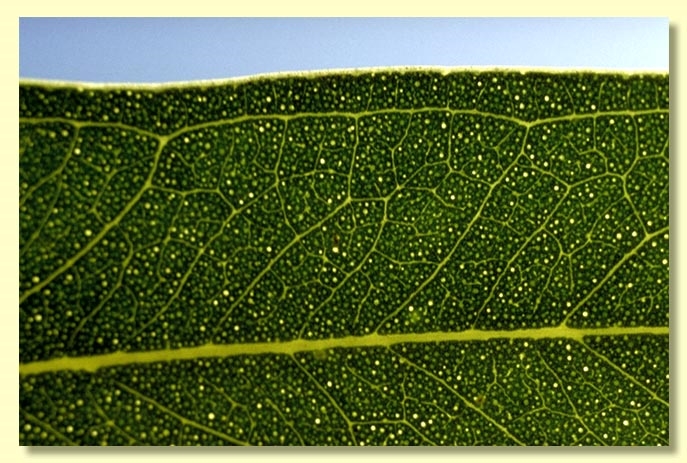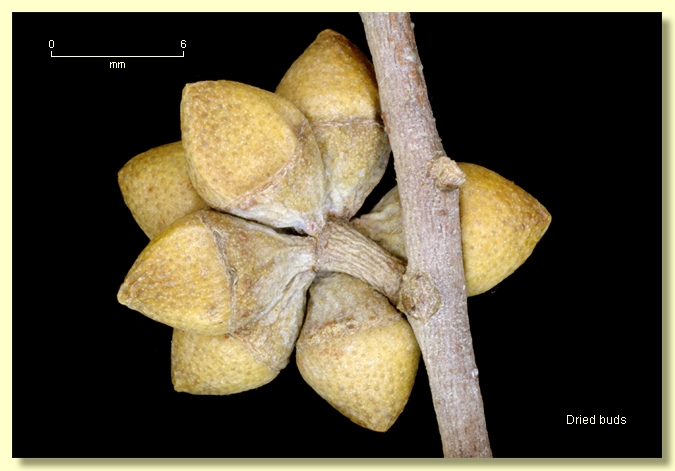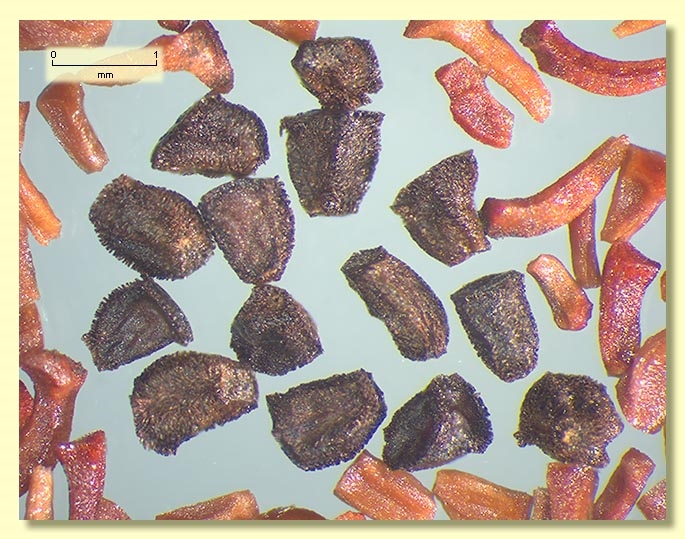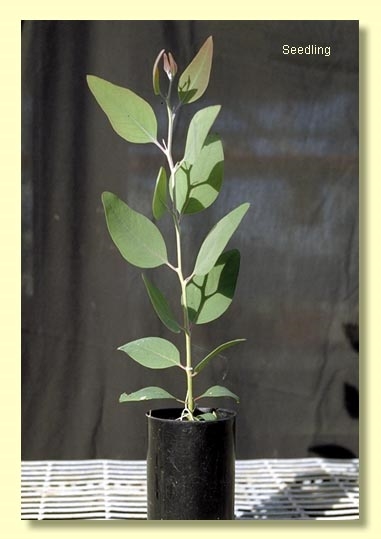Euclid - Online edition
Eucalyptus vicina
Eucalyptus | Symphyomyrtus | Exsertaria | Erythroxylon
Tree or mallee to 8 m tall. Forming a lignotuber.
Bark usually smooth throughout, often powdery, mottled grey, brown, coppery, pink, orange and white.
Branchlets may be glaucous or not.
Juvenile growth (coppice or field seedlings to 50 cm): stems square in cross-section, usually glaucous; juvenile leaves always petiolate, opposite for 5 or 6 nodes then alternate, ovate, 5–9 cm long, 2.5–4.8 cm wide, base tapering to petiole or almost truncate, green to blue-green or slightly glaucous.
Adult leaves alternate, petiole 1–3.5 cm long; blade lanceolate to falcate, 5.5–16 cm long, 0.7–2.7 cm wide, base tapering to petiole, concolorous, glossy or dull, green, side-veins greater than 45° to midrib, moderately reticulate, intramarginal vein parallel to and well removed from margin, oil glands mostly island.
Inflorescence axillary unbranched, peduncles 0.3–0.8 cm long, buds 7, sessile or pedicellate (pedicels 0–0.2 cm long). Mature buds ovoid to diamond-shaped (0.6–1 cm long, 0.3–0.6 cm wide), green to creamy or glaucous, scar present, operculum conical to rounded (0.4–0.7 cm long), outer stamens erect, the inner inflexed or irregularly flexed, anthers cuboid or cuneate, versatile, dorsifixed, dehiscing by longitudinal slits (non-confluent), style long, stigma tapered, locules 3 or 4, the placentae each with 6 vertical ovule rows. Flowers white.
Fruit sessile or pedicellate (pedicels 0–0.3 cm long), cup-shaped or hemispherical, 0.4–0.6 cm long, 0.4–0.8 cm wide, disc slightly raised, level or slightly descending, valves 3 or 4, strongly exserted or near rim level.
Seeds dark brown or black, 0.7–1.2 mm long, pyramidal or cuboid, dorsal surface usually pitted, hilum terminal.
Cultivated seedlings (measured at ca node 10): cotyledons reniform to oblong; stems square in cross-section; leaves petiolate, opposite for 5 or 6 nodes then becoming alternate, ovate, 5–10 cm long, 2.5–5 cm wide, base truncate to tapering, apex pointed to rounded, dull, glaucous weathering to green.
Flowering has been recorded in June, September and October.
A small smooth-barked tree or mallee of scattered distribution in far western New South Wales north and west of the Lachlan River and east of the Darling River, on stony hills. E. vicina has a green-leaved crown, small ovoid/diamond-shaped buds in axillary clusters and fruit with exserted valves.
Eucalyptus vicina belongs to the group of red gums which is distinguished by having buds with the stamens mostly erect, fruit where the disc is united to the ovary roof and by the black, toothed, cuboid to pyramidal single-coated seed. Fifteen species belong to this group: E. amplifolia, E. blakelyi, E. chloroclada, E. dealbata, E. dwyeri, E. flindersii, E. gillenii, E. glaucina, E. infera, E. kabiana, E. nandewarica, E. nudicaulis, E. tereticornis, E. terrica and E. vicina.
E. vicina is closely related to E. dealbata and E. blakelyi. All three have relatively broad ovate juvenile leaves. It differs from E. dealbata by the lack of glaucescence in the adult plant, although the juvenile leaves are slightly glaucous. E. blakelyi differs by having buds with a longer narrow operculum. E. dwyeri is also close to E. vicina. It differs by having much longer and narrower juvenile leaves, usually less than 2.5 cm wide in E. dwyeri and greater than 2.5 cm in E. vicina. There is a large zone of intergradation with E. dwyeri on hills south and immediately north of the Lachlan River, e.g. Monia Gap, Sims Gap. E. nandewarica, from an enclave in foothills near Kaputar north-east of Coonabarabran; E. gillenii, from central Australia; and E. nudicaulis, from the Mt Isa region in the north-western part of Queensland, also differ from E. vicina by having the narrow juveniles like E. dwyeri.
E. amplifolia from subcoastal and tableland areas of New South Wales and south-east Queensland, E. tereticornis, a common tree in eastern Australia from Bega to the top of Cape York Peninsula and E. glaucina from the low coastal ranges and tablelands of central-northern New South Wales differ by having large ovate to orbicular to deltoid juvenile leaves. E. tereticornis can be further separated by having buds with a much longer narrower operculum than E. vicina. E. kabiana , from Mt Beerwah in the Glasshouse Mountains, also differs by having buds with a longer narrow operculum like E. tereticornis. E. chloroclada from the western slopes and plains of New South Wales, from the Pilliga area northwards into the Texas, Cracow, Tambo, Dirranbandi area of south-east Queensland and E. terrica, from the Inglewood and Warwick region of south-east Queensland, differ by normally having rough bark on their trunk. E. infera, an odd eucalypt from the Warwick region in Queensland, has typical red gum buds and fruit but has juvenile leaves similar to those of the swamp gum E. camphora, which are ovate to orbicular, with an emarginate apex and margins often with shallow crenulations. E. flindersii, from the slopes and summits of peaks in the Northern Flinders Range and some nearby areas of South Australia, has broadly ovate to ovate, dull, green to grey-green juvenile leaves (never glaucous as they can be in E. vicina ) and inflorescences which are commonly three-budded in each umbel.
Trees attributed to E. vicina in the Mootwingie Hills west of the River Darling are of uncertain identity, possibly being complicated by introgression of E. camaldulensis subsp. camaldulensis with another (?hill-dwelling) red gum as seen by inspection of the seed lots which show mixtures of single-coated black and double-coated yellow seed from individual plants, or the seedlots may be entirely of black seed or only yellow seed. The seedlings are more like those of E. camaldulensis subsp. camaldulensis than E. vicina, having longer lanceolate leaves.














